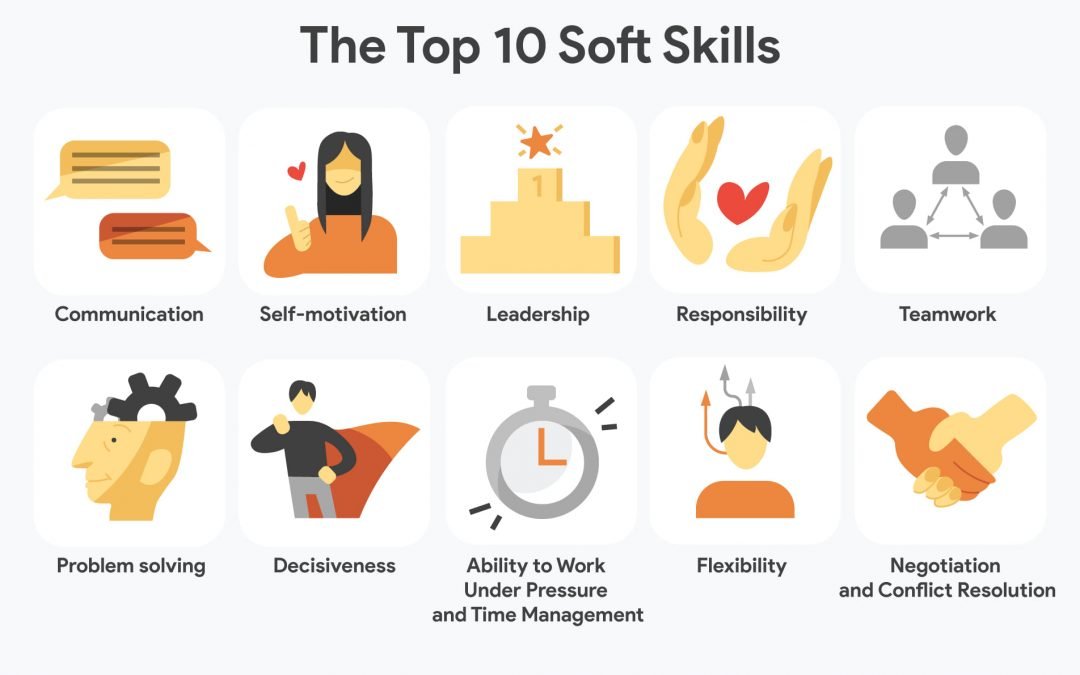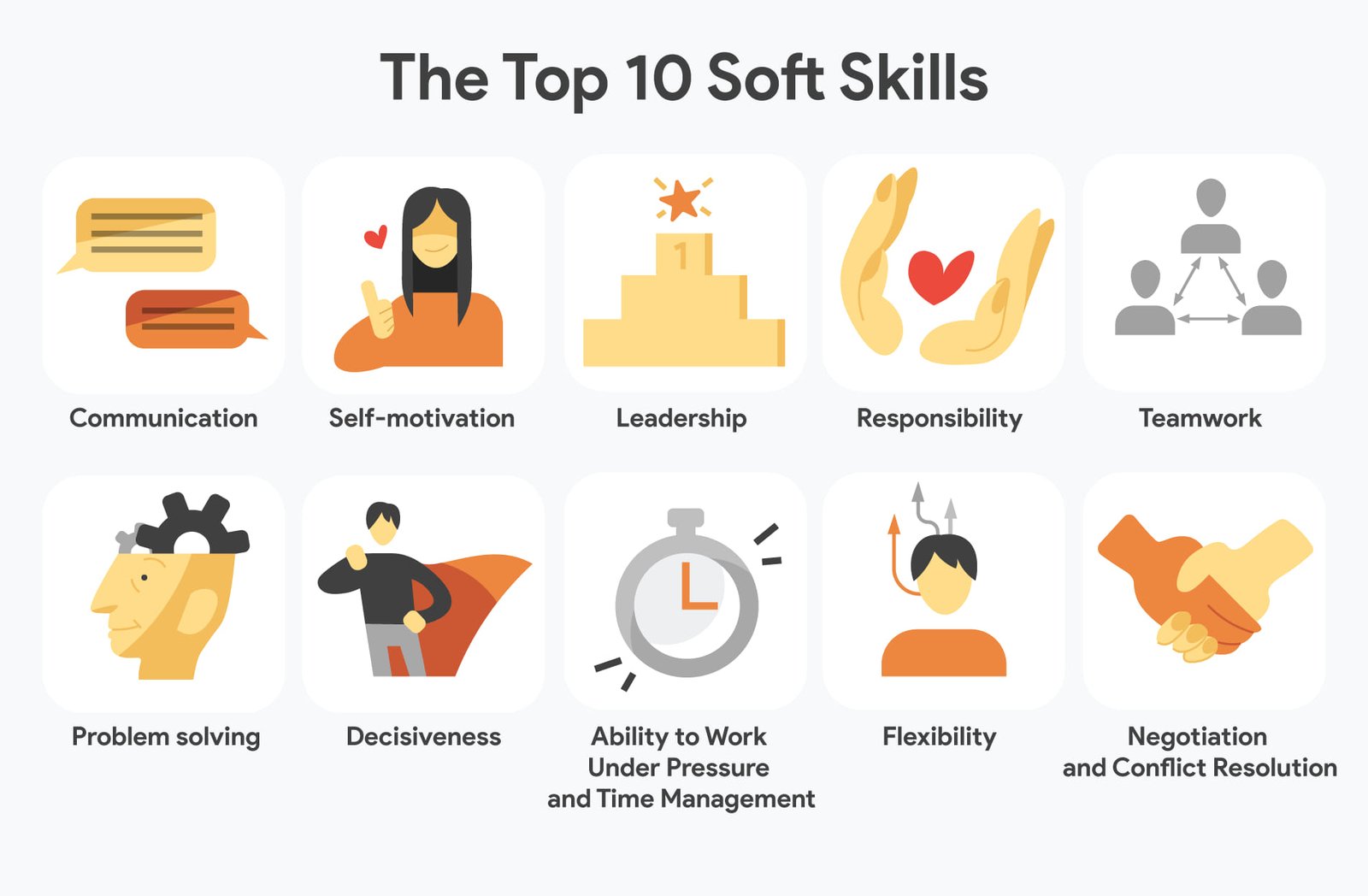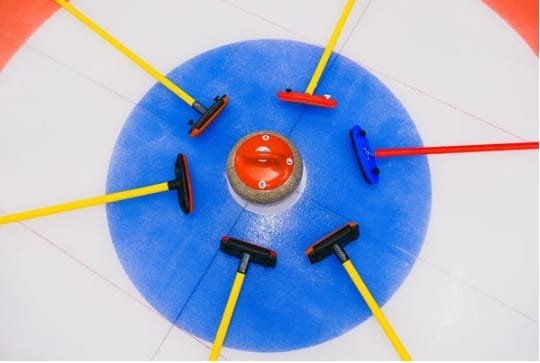
by admin | May 30, 2022 | General
Soft Skills & How To Improve Them
If you are looking to step up your personal development game, developing a set of soft skills may be even more important than your actual, technical skills. Soft skills are all the traits and characteristics that you develop through communication with peers or even on your work place. In this article, we’ll shed light on what soft skills actually are and what you can do to improve them.
What Are Soft Skills?

As we mentioned, soft skills are more related to your social dynamics, rather than the technical knowledge and skills that you have. That is to say that soft skills (also known as “core skills”) are the skills that enable you to master hardly controlled actions.
That includes but is not limited to:
- Public speaking
- Work ethic
- Leadership
- Problem solving
- Critical thinking
This set of skills is applicable to any endeavor and is essential to your personal development. To further help you understand exactly what this means, let’s have a look at the 3 most important soft skills to develop – Creativity, Adaptability, Communication.
Creativity
Creative thinking can be placed at the core of your skillset for ANY given position, because that is simply, the human factor. As technology advances, more and more robots start replacing work positions BUT they are not creative like humans are. Now, in this context, creativity doesn’t have to do with art for example, but is rather related to your ability to work with information.
In essence, creativity would be your ability to connect otherwise unrelated facts, which can massively boost your problem solving skills and can even help you create an innovation.
Adaptability
Contrary to the quite simple past, where you had just a pool of careers to choose from, the dynamic, modern-day world DEMANDS you to be adaptable. For this reason, being flexible and adaptable to change is of prime importance for your personal development skillset. On top of that, this would require you to always be open to learning new things, because this is the time when you often have to learn how to work with newly implemented changes, technologies and other conditions.
Learn more, do more diverse things and what you already know how to do, try to do differently!
Communication

Regardless of your job position or the career path you’re trying to follow, your social skills are a make or break factor. The truth is, whether you’re working for someone, or on your own business, you will ALWAYS have colleagues, clients, managers, etc. Besides being able to speak and write, learning social psychology is also a crucial skill for any job position.
This will allow you to understand each individual, without reacting emotionally and in the face of social conflict, you’d be firm on your feet and have the ability to bring everyone to consensus. In your quest to find common language with people that have different views, you learn how to speak your mind out in front of anyone.
Take-Home Message
Soft skills are an important part of your character development, as they can be used virtually in any position, career path or business. Though essential, creativity, adaptability and communication are just 3 of the many soft skills that are useful. You have to find the ones that are most relevant in your specific case, for your career, job, business or whatever it is that you are doing.
In developing those, you will be able to create a better work/social flow, making everything easy to adhere to and enjoy.

by admin | May 30, 2022 | General
Soft Skills VS Hard Skills – What’s the Difference?
Soft and hard skills are two of the most crucial elements, whether you are applying to a job, or are looking to partner up with someone for the successful realization of your business idea. Both of these are essential for a sustainable work process, but what really are those skills and what is the difference between them?
Let’s Find Out!
Soft VS Hard Skills
The key differences between soft and hard skills is the means of acquiring and application throughout the work process.
Hard skills are mostly acquired through a methodical education or a specific training program. Having this means you are competent and more technical, whether it is about working with software, or working with machinery. In essence, hard skills are all your technical skills that concern a certain job position or business idea.
Soft skills on the other hand are more related to your personal characteristics and traits, which you have acquired through your life experience. For instance, some of the core soft skills include time management, communication, stress management, problem solving and critical thinking.
To put it simply – Hard skills can be defined as all the technical knowledge required for a certain position, while soft skills are universal behaviors and habits that can be applied to any position.
What Are The Most Important Soft Skills?

As we just mentioned, soft skills are your character traits and social behavior, which dictate how you work alone, or with a team. Though technical, hard skills are required in most job positions, soft skills allow you to create a sustainable and optimally functional working environment.
Here are some of the most important soft skills to adopt:
- Reliability
- Creativity
- Adaptivity
- Problem solving
- Openness to learning
- Effective communication
- Critical thinking
In learning those, you will undoubtedly create a more positive relationship with your work place or business environment
What About Hard Skills?

Now, for the most part, hard skills are more specific, as different positions require different technical knowledge. However, for the most part, there are a couple of core hard skills that are applicable in most places.
Those are namely:
- App development
- Statistics
- Fluency in several languages
- Content creation
In acquiring those, as well as the ones your specific position requires, you make it far more likely to create a seamless workflow with zero to no mistakes.
Do I Really Need Any Of That?
This question often comes to mind, but the answer is very simple… You don’t NEED anything, when there is no context. Considering however, that we live in a dynamic world, acquiring more and new technical skills and character traits is important when it comes to putting out the greatest value possible.
Needless to say, that value given out, will result in benefits flowing in, whether that is a raise from your boss at work, or a successful realization of a business idea. Work on yourself, learn more, do more!

by admin | May 30, 2022 | General
SPRING BREAK OR SPRING BREAK UP ?
What do we need to embrace and what are we letting go?
Spring is almost here, and summer is just around the corner. It is a period of transition in many respects and a time to readapt in others. I name it The Good, The Bad, and The Ugly. But don’t take me as a pessimist; I’m just a reality whisperer explaining the spring rites of passage that occur every year when we de-layer our life to summer mode, in more ways than one… so here we go.
The Good:

Great weather is on the way, the plants are reviving, and the animals are waking up to retake their summer territory. People emerge from their winter slumber and examine their life during this renewal period, an ambition of thinking in search of the good, bad, and ugly realisations of their lives. They examine their current position and brainstorm solutions to enhance their lives.
After all, it is spring, and nothing is more lovely, though some argue that Autumn is more beautiful. To each their own, but I like to wear fewer layers rather than bundle up in restricting layers of clothing! After experiencing the joys of spring, now comes…
The Bad:

Let’s face it, most of us acquired a little more padding to get through the harsh winter days, or we had a few extra pounds from the holidays. But no more concealing it behind layers of clothing. You may well be the one with the cuddly coat on the beach. For the rest of us it’s time to figure out how to reduce weight and flatten our stomachs.
To start the fat burning going, we need to devise a strategy that you can stick to. For the purpose of devoting time to the gym. If you, like me, despise the restrictions of a gym, it’s time to discover a home training regimen and stick to it. Invest in a fitness plan to help you combine a healthy diet with specific activities, or maybe you prefer a video series that will help you burn calories.
It is not tough to lose those pounds; all it needs is the will and discipline to get started. And, sure, the six-pack abs may be regained, as can the belly “muffin” fat. Invest in yourself by finding a program that can kickstart your fat-burning processes. A plan is a worthwhile investment in your future and wellness. It might assist or counteract the unfortunate reality that spring brings to many individuals this time of year…
The Ugly:
For some, the changing season raises concerns about their relationships. The human drive to discover what else is out there strangely leads to unexpected spring breakups.
Maybe it’s the end of the school year, and couples are thinking about the perceived difficulties of being geographically separated for the summer. Or it’s the graduation breakup when the man or lady begins to have doubts about the relationship’s ability to withstand the transfer to the “real world.”
Others may be experiencing cascade troubles due to the winter’s cabin fever, leading them to wonder what else is out there. There will always be a suffering partner who doesn’t understand why, regardless of the situation.
And Maybe you’re correct, and the breakup was a mistake.
This problem will make or break their summer for these individuals. It is time to seek outside relationship counsel to help you navigate a second shot at reuniting with your ex. A third party or a written guide takes you to solutions to difficult problems such as, “Can I get my ex back?” If that’s the case, what’s the best method to go about it? More importantly, what activities should you avoid that permanently damage the relationship? Should you just let it go and move on?
Friends and relatives might be comforting, but they often provide the worst counsel. You need a source who does not have a pre-existing view, positive or negative, on the ex. Look for a reputable provider that has assisted thousands of couples. The human race has endured and healed from breakups that made life seem unbearably difficult. Don’t squander your chances or your time. Work on a method to reclaim them or move on!
Yes, spring offers a slew of new challenges. The good news is that they are readily surmountable. There will be cleansing in many ways, maybe fixing, renewal , maybe acceptance to let of things, jobs, situations and even people. Be kind to yourself but also be open minded.
So come on, let’s get started and make this summer greater than the previous ones. Starting this Spring.

by admin | May 30, 2022 | General, Health
Spring Detox – Herbs For Detoxification
Spring a time for detox and herbs are one of the best ways to aid that detox and cleanse.
Herbal remedies are also seeing a rise in popularity once again. This includes using herbs for detoxification. Many people like the idea of using herbs as natural products have minimal side effects. Herbs in fact have many therapeutic abilities. The following list explains some western herbs commonly used for detoxification and why they work.
Dandelion

– This is an herb that is good for the whole body, specifically the immune system. It works to eliminate toxins from the cells in the body. It also increases bile and helps it move along. It is credited with boosting white blood cells thus strengthening the immune system.
Liquorice Root – This herb has properties that work like an antioxidant, fight viruses and helps the body produce antibodies.
Cascara Sagrada – This herb works like a laxative. It helps the bowels move.
Black Walnut Hulls – This herb also works in the bowels. It works against parasites and removes them from the intestines. It also helps remove fatty material and toxins.
Garlic – Garlic is the classic kitchen-pharmacy remedy and has been used for centuries as an antiseptic. It detoxifies the gut and helps the bowels function properly. It works like a laxative in making the bowels move regularly.
Goldenseal – this herb is well known for its cleansing power. It can rid the body of toxins and help to remove obstructions.
Psyllium – This herb also works to help move the bowels.
Here are some Chinese herbs that are used for detoxification.
Lian Qiao is the forsythia flower. It has a cleansing action and helps to clear heat and toxins.
Ju Hua Otherwise known as the Chrysanthemum. This is a pungent herb that should not be overcooked, or it will lose its potency. It has cleansing properties.
Pu Gong Ying

is the dandelion plant. It is the parts of the plant above the root that is being used as a remedy. It is effective as a detoxification herb. It is important to know that the main point of detoxification is removing toxins from the body, usually through the bowels. Using herbs is gentler on your system than other methods and you get additional benefits from the nutrients that herbs supply.
If in doubt always consult a herbalist or naturopath.

by admin | May 30, 2022 | General
How To Train On A Busy Schedule
In the modern-day world where being sedentary has become the new normal, the lack of proper movement is globally acknowledged. For this reason, many types of activities have become increasingly popular, with one being predominant. That is namely weight training, which has now become the most common type of training that people engage in.
Nevertheless, training in a gym may be time consuming if not optimized, which is why you often hear people say that they simply “don’t have time” to train. In this article, we’ll give you tips and tricks on how to create an effective workout routine that fits your schedule (even if it’s a busy one).
Why Even Train?

If you are not sure about whether or not you should start training in the first place, let us tell you this – A moving body is a healthy body. Being sedentary is one of the MAIN reasons why people are exhausted, depressed and in bad shape. The benefits of training and especially weight training are literally COUNTLESS.
But when you think about it, it makes sense – The body has a complex muscular and nervous system because it was BUILT FOR HIGH PERFORMANCE. Certainly, the body is NOT a vessel for sensory pleasure – There is much more to existence. Movement stimulates all bodily systems and improves overall health in the long-term, if done correctly. In simple words, the question should not be “Should I train or not?” but rather “What can I do for my body to favor all my internal processes?”
What Should I Know About Training?
Though highly effective, weight training is very misunderstood, especially considering the oceans of information on the internet. However, we have piled up the MOST IMPORTANT things you should know about weight training. Here’s a list.
- Training intensity
All your working sets should be at a moderately high/high intensity, where the set is challenging and takes you close to muscular failure (the inability to complete another rep unassisted). This creates a sufficient, powerful stimulus for the development of your muscular and nervous system. Generally, training in the 1-5 rep range with heavy weights will induce maximum strength gains, while training in the 6-15 rep range will be a greater stimulus for bulk muscle growth.
Your best bet is to combine both but focus on the one which resonates with your goals most.
- Training volume
As a beginner, you should aim to complete up to 10 challenging working sets, per muscle group, per week. The more you progress, the more that volume grows – This will help you create new, additional stimulus, to which the body has not yet adapted/
- Rest times & Recovery
A general rule of thumb to follow, is that your rest-times between sets are longer, the heavier you lift, because intensity by nature is demanding. If you’re training in the 1-5 rep range, you should take up to 5+ minutes of rest between sets, and if you’re in the 6-15 rep range, that would be around 3 minutes of rest between sets.
After you’re done training a muscle group, you should give it 48-96 hours of recovery time, before training it again – If you are doing a full-body workout, you can be on the lower range of that time frame.
- Exercise choice
In general, and especially in the case of a busy schedule, compound movements should be the main focus of your workouts. Compound movements are exercises that engage multiple muscle groups at once – These exercises allow you to lift heavier weight and thus, create a greater stimulus.
Think of squats, bench, deadlift, overhead presses and all their variations.
Sample Training Regimen

Below you can find a sample training regimen for people on a busy schedule. This training split offers a variety of compound movements that target the entire body. The workout should take roughly one hour to complete and due to the low number of working sets, it can be done every other day. In the table below, you can find each exercise, the sets, reps, rest times as well as possible substitutes for each exercise.
Full Body Split – ~60 min completion time
| Exercise |
Sets |
Reps |
Rest times |
| Flat Barbell Bench Press or incline dumbbell bench press |
2 warm-up sets, 3 working sets |
6-10 |
3 minutes between working sets |
| Vertical Lat Pulldown or T-bar row |
3 working sets |
10 |
2.5 minutes between working sets |
| Overhead Presses or lateral raises |
3 working sets |
8-10 |
3 minutes between working sets |
| Squats or leg presses |
3 Working Sets |
10 |
3 minutes between working sets |
| Standing or seated Calf Raises |
3 working sets |
10 |
2.5 minutes between working sets |
Conclusion
Creating an effective training regimen on a busy schedule can be a hassle, but as long as you follow the general guidelines provided, you can create an effective training split. Needless to say, you will invest some of your time in this, but if optimized and done correctly, the investment will pay off. With a well-optimized regimen, you’re looking at about 5-6 hours of training PER WEEK.
You have 168 hours in a week.
If you work a normal day job, you’d have 40 of those 168 hours going to your workplace. A regular sleeping pattern will take up to 56 hours per week. You’re left with 72 hours to do whatever you have to/want to do.
The choice is yours!

by admin | May 30, 2022 | General
How To Train Smart | PT 2 – Understanding Your Goals & Setting The Plan
If you have no formal education on fitness and nutrition, odds are that you are just testing around to see what works for you. However, if you have a goal in mind, there are specific actions to be taken towards that goal, because, well, training results are predictable! So let’s have a look at how you can define your goal with training and more importantly, what things you need to do to set the plan right.
Common Training Goals

Going into the gym, there are a couple of types of people:
- Really skinny people, trying to grow
- People with excess weight, trying to shed it off
- Individuals with a normal body composition looking to improve
So let’s have a look at each one of those and what are some actions you can take towards setting your plan in place.
The Hardgainer
As we mentioned, there are many people who are really skinny and try to gain weight by training. If that’s the case for you, take the following guidelines:
- Start training at moderate intensity (6-10 reps with a weight that leaves plenty of repetitions in reserve)
- Focus on learning the correct exercise form
- Rest at least 2 minutes between sets
- Start off with ~5 working sets per muscle group, per week
- Increase the number of sets progressively
- Allow each muscle group to recover for at least 72 hrs before training it again
- Eat, eat, eat, eat, eat!
Doing all of this over at least a year will likely lead you to be, well, not so skinny anymore! Furthermore, this will set the fundament for more growth, which you can build upon.
The Fluffgainer

Hey, listen, if you’ve been inactive for some time and have enjoyed your favorite foods in big amounts, that’s alright, you’ve just relaxed for a little bit. Getting back on track and losing the excess weight will be fulfilling and with a bit of training and nutrition, you can do wonders.
Follow these tips!
- Train at moderate levels of intensity (a couple of reps shy from failure)
- Rest ~2-3 minutes between sets
- Do ~10 challenging working sets per muscle group, per week
- Allow each muscle group to recover 72-96 hours
- Eat in a caloric deficit (most important part)
- Consume plenty of protein (~1g per lb of body weight, per day)
- Consume plenty of natural fats (~0.45g per lb of body weight, per day)
- Consume some carbs to fuel training
In doing this, you will allow the body to tap into its fat reserves to compensate for the deficit of energy, and you will also create sufficient stimulus for muscle mass retention.
The Normie

If you’re someone who has a normal body composition and is neither fluffy nor skinny and sustains healthy eating habits, well, you have a good foundation! In case your primary form of training involves weights, define your goal and train accordingly to the guidelines below:
- Use the powerlifting rep range mentioned in PT 1 of the article series, for the goal of increasing maximum strength
- Use the bodybuilding rep range mentioned in PT 1, for the goal of bulk muscle growth
- If you want to be more functional and not just strong and big, combine weight training with activities like climbing, running, hiking, swimming, etc.
- Maintain your regular eating habits, but add more food as you become more active!
Generally, people with a normal body composition are well-tuned to their hunger and satiety signals, so no specific diet changes are required.
Final Thoughts
Training smart is about recognizing your goal and setting the correct training stimulus in place. Most hardgainers should focus around moderate and high intensity training that progressively increases in time.
People who lose weight on the other hand are also prone to eventually losing muscle mass, so training at a moderate level of exertion and intensity will create sufficient stimulus for the retention of that muscle mass, thus helping the person look more toned through their journey.
Whatever your goal may be, do analyze the backend of your workouts and take actions accordingly, if any change is needed!
Page 6 of 7« First«...34567»

























